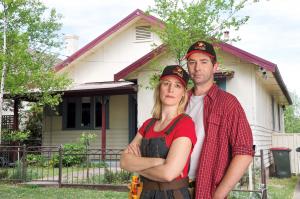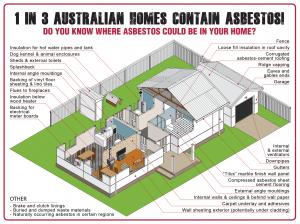Australians Told ‘Stop Playing Renovation Roulette!’ Amid Renovation Boom
The National Asbestos Awareness Month campaign (1-30 Nov) aims to reduce asbestos-related diseases by urging Australians to ‘Stop playing renovation roulette’.
Currently the popularity of renovating has reached frenzied proportions with billions of dollars saved during the pandemic being spent on home renovations. With one-in-three homes containing asbestos and more than one-in-three homeowners undertaking renovations, (a 37% increase according to RateCity.com.au); serious concerns have been raised that DIY renovators and tradies might be risking their lives and the lives of their families if they fail to respect the potentially life-threatening risks of asbestos if it’s not managed safely.
Asbestos-containing products are not just found in fibro homes. They were used extensively in brick, weatherboard, clad homes and apartments. If undisturbed, well maintained and in stable, sealed condition, these products are considered unlikely to pose health risks. However, just as electricity is invisible and can be deadly, asbestos can be equally lethal when invisible fibres are disturbed and inhaled if asbestos is not managed safely during renovations, maintenance, removal or during the demolition of older properties.
With Australians diverting a record one-billion-dollars a month towards home renovations, research has found that while 40% of DIYers surveyed who worked on a property containing asbestos, only 5% knew of the high risks to health associated with asbestos compared to 22% being aware of the high risks associated with electricity.
Like electricity, asbestos fibres are invisible and can pose long-term and life-threatening health risks often related to the frequency and level of exposure, the higher the exposure, the greater health risk. However, even small amounts of exposure to fibres can lead to asbestos-related diseases, which is why dealing unsafely with any amount of asbestos is likened to playing renovation roulette - there is no known safe level of exposure.
While deaths from electricity exposure can be immediate, it can take 20-50 years before asbestos-related diseases are detected including malignant mesothelioma, a rare and progressive cancer caused by asbestos fibre exposure. There is no cure. The average survival time after diagnosis is 10-12 months.
With asbestos fibres used in the manufacture of over 3000 building and decorator products that can be in any home built or renovated before 1990, Australians must learn to respect the invisible dangers of asbestos just as we respect the invisible dangers of electricity.
According Australia’s National Coronial Information System, electrocution during home maintenance and DIY renovations causes 2.7 deaths of homeowners annually, while SafeWork Australia’s Preliminary Worker Deaths by Industry of Workplace reports 3 deaths of workers in the electricity, gas, water and waste services industries this year, and zero in 2020.
With a staggering 4000 deaths annually from asbestos-related diseases including asbestosis and lung cancer, and an alarming number of deaths from mesothelioma attributed to both occupational and non-occupational exposure during residential renovations; it’s clear both homeowners and tradespersons must start to respect asbestos risks.
Because Australia was among the highest consumers of asbestos globally, we also have one of highest incidences of mesothelioma in the world with a steady increase in recorded cases since 1980.
When the Australian Mesothelioma Registry (AMR) published its most recent report documenting 724 mesothelioma deaths and 659 newly diagnosed cases, the AMR also predicted the number of recorded deaths will increase due to both occupational and non-occupational (renovators) exposure.
With experts predicting a continued rise in the third-wave of asbestos-related diseases caused from exposure during renovating or maintaining older properties; the collective data on exposure, together with the data on the current surge in home renovations has raised significant concerns.
Cherie Barber, Australia’s Renovation Queen™ is an Ambassador for the National Asbestos Awareness Campaign. Having lost her grandfather to asbestos-related disease, Cherie knows the devastating impact asbestos has on health, and is passionate about educating homeowners and DIYers on how to renovate homes with asbestos safely.
“Homeowners, renovators and tradies must respect asbestos and learn how to manage it safely by visiting Australia’s most comprehensive, trusted source of asbestos information, asbestosawareness.com.au,” Ms Barber said.
“With one-third of Aussie homes containing asbestos, Australians must stop playing renovation roulette and start to respect the ‘invisible’ dangers of asbestos just as we respect the dangers of electricity and would only use licenced electricians to do electrical work.
“If you suspect your home may contain asbestos, before taking up tools engage the professionals such as an occupational hygienist or an asbestos assessor to test for asbestos and only use licenced asbestos removalists because it’s not worth the risk!” Ms Barber said.
Australia’s longest running, multi-award winning National Asbestos Awareness campaign directs homeowners, renovators and tradies to Australia’s leading, most comprehensive, information source, asbestosawareness.com.au which has had over 2.2million pageviews and more than 1 million sessions since 2011.
The importance of continuing the Asbestos Awareness Month campaign and asbestosawareness.com.au in the prevention of asbestos-related diseases cannot be overstated with funding desperately needed to continue both the campaign and website beyond 2021.
London based Laurie Kazan-Allen, Coordinator of the International Ban Asbestos Secretariat and a respected world-leading authority for more than 30 years said, “It’s not just that asbestosawareness.com.au was amongst the very first tailor-made online asbestos resources in Australia; but it has consistently been ahead of the curve in its messaging, outreach work and strategic plans for raising awareness of the asbestos hazard throughout the country.
“The website is indeed a one-stop-shop for all sorts of stakeholders including homeowners, tradies, local councils, property managers, farmers and more. To my mind, two of the best features of the site are its accessibility and lack of intimidation. Information is presented clearly with links for further research and provides resources for multi-lingual communities reinforcing the inclusivity of the campaign behind this invaluable resource,” she said.
Stop playing renovation roulette and visit asbestosawareness.com.au, it’s not worth the risk!
Alice Collins
Insight Communications
+61 2 9518 4744
email us here
Visit us on social media:
Facebook
Stop playing renovation roulette! It's not worth the risk.
Legal Disclaimer:
EIN Presswire provides this news content "as is" without warranty of any kind. We do not accept any responsibility or liability for the accuracy, content, images, videos, licenses, completeness, legality, or reliability of the information contained in this article. If you have any complaints or copyright issues related to this article, kindly contact the author above.


